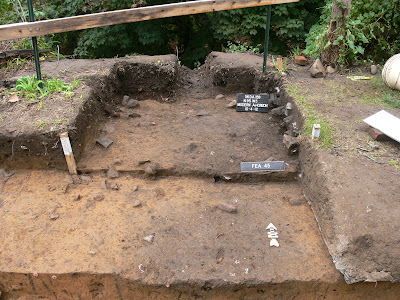 |
| Feature which we now believe is the corner of a foundation. |
Excavations continued this week at Fort Hunter and with only one day lost to rain we were able to make some headway on our main objectives this year – the well and the feature/soil anomaly in the front yard. The damp drizzle this week, while somewhat of a hindrance, allowed for soil stains to “pop” or stand out in some of the units as was the case in unit N90 W10, on the north side of the well. We have been investigating a line of rocks in the northwest corner of the excavation block and this week discovered that it makes a right angle turn to the west. We are now feeling pretty confident that it represents some type of structure (Initially, it was felt that it represented a French drain or wall). On the "inside" of this structure, quantities of coal and mortar were recovered from what appears to be a level floor. Understanding the age and function of this structure will require opening additional units next year.
 |
| Fartherest north unit in excavation block on the edge of the bank above Fishing Creek.. |
Also on the north side of the well, we expanded our excavation block another five feet to the edge of the bluff overlooking Fishing Creek. This is unit N95W5 and it is east and north of the previously noted unit. Feature 45 extends into this unit from N90W5. This feature produced ceramics, glass, nails and mortar from the 19th and 20th century but there were no stockade posts or fort related artifacts recovered. Further to the south, in N80W5, level 4 in the prehistoric occupation was removed. South of the well, this level produced Late Archaic artifacts including bipolar cores used in lithic reduction. This area will provide additional data on this time period and hopefully more on lithic technology.
Moving further to the south brings us to the well. We are currently 13.24 feet below datum (BD) in the well shaft. We are working towards our goal of 16 feet BD. For those of you unfamiliar with archaeological excavation methods, the datum is an arbitrarily determined point from which all vertical measurements are taken. This datum point is important in establishing arbitrary levels and in recording the natural and cultural stratigraphy of the site.
 |
| On of our regular volunteers, Phil, in the well. |
Last year large rocks were encountered at this level which blocked our ability to auger (drill) to the bottom of the well. In order to evaluate the potential for recovering 18th century artifacts, we need to get below this level. Assuming we have about three days of good weather and sufficient volunteers, we should be able to remove the large rocks and begin augering to the bottom by Tuesday or Wednesday of next week.
 |
| Augering the front yard, North Street is behind Jerry in this photo. |
We began augering in the front yard to develop a more compressive understanding of the stratigraphy. Two years ago we identified what appears to be a ditch or road in this area but soil scientists argued that it was a natural profile. Based on the results of this week’s testing, it appears that this anomaly has a limited horizontal distribution (and therefore probably cultural in origin) and may well represent the ditch surrounding the fort or a road leading to the fort. We will continue augering next week in order to better map this feature.
 |
| Dr. Kurt Carr at Indian Festival Day demonstrating the proper technique for launching an atlatl. |
This Sunday, October 7th, is the Pennsylvania Indian Festival at Fort Hunter Mansion and Park . These is our last big public event during our field work season so if you haven’t stopped by yet, please take the time to come over to the site. Visitors are always amazed at the information we share with them and the observance that “all of this is just below our feet”. Other activities scheduled for the day include an opportunity to launch a spear using an atlatl. The atlatl, or spear thrower, was used by Native Americans more than 9000 years ago to hunt animals such as elk, bear and deer. Dr. Kurt Carr from The State Museum will be on hand to demonstrate and instruct participants in the proper form and technique. The forecast of cool temps on Sunday will be perfect for a bowl of warm venison stew and corn bread.
 |
| Steve Nissly discusses flint knapping with 2011 Archaeology Workshops participants. |
Remember the Workshops in Archaeology program is less than a month from now, November 3rd. The 2012 Annual Workshops link on the upper right side of this blog will provide you with a registration form and program. Mark your calendar and send in your registration form for this daylong event that is sure to offer participants an opportunity to learn more about the struggle which ensued in Pennsylvania during this time of contact, settlement and eventually colonization. This program will appeal to both historians and archaeology enthusiasts as we explore both the historic documents and the archaeological evidence for these events in the commonwealth. Archaeologists are examining these important sites in an attempt to better understand this volatile period and the role that citizens some 250 years ago played in the colonization process. We hope you can join us at one of these events and be sure to check the Society for Pennsylvania Archaeology web site for additional events held throughout the month of October for Archaeology Month.
 |
| Annual Archaeology Month Poster, October 2012. |
For more information, visit PAarchaeology.state.pa.us or the Hall of Anthropology and Archaeology at The State Museum of Pennsylvania .

No comments:
Post a Comment